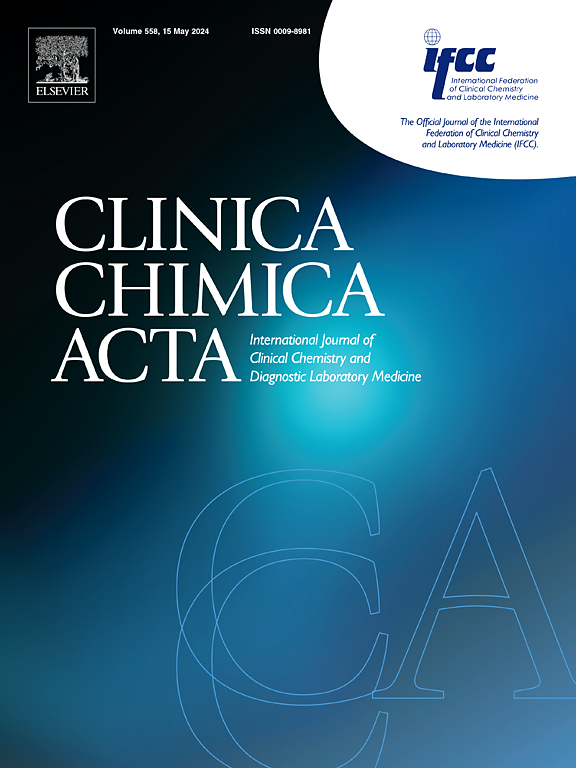Three cases of false decrease interference of etamsylate on biochemical laboratory tests and correction methods
IF 2.9
3区 医学
Q2 MEDICAL LABORATORY TECHNOLOGY
引用次数: 0
Abstract
Background
Etamsylate, a commonly used clinical hemostatic agent, may cause false decreases in biochemical test results through inhibition of enzymatic activity or interference with chromogenic reactions. However, insufficient research on its interference mechanisms and correction methods increases the risk of clinical misjudgment.
Methods
Serum samples were collected from three patients treated with etamsylate and analyzed using the Roche Cobas 8000 c701 automated biochemical analyzer. Samples were tested at undiluted (0-fold), 3-fold, 5-fold, and 10-fold dilution gradients to evaluate drug interference characteristics and the efficacy of dilution-based correction.
Results
Among the 46 routine biochemical assays evaluated, etamsylate exhibited significant negative interference on 12 parameters, including creatinine (CREA), albumin (ALB), and cholyglycine (CG). The interference diminished linearly with increasing dilution factors, demonstrating a dose-dependent recovery trend. CG demonstrated the most pronounced changes. No significant interference was observed for 12 other tests, such as alanine aminotransferase (ALT) and aspartate aminotransferase (AST). Following dilution, six parameters, including apolipoprotein A1 (APOA1), apolipoprotein A2 (APOA2), and apolipoprotein B (APOB), exhibited a paradoxical decrease in assay results, suggesting the presence of distinct interference mechanisms.
Conclusion
The dilution method can effectively correct the false decrease interference of etamsylate on biochemical detection. However, it is necessary to optimize the dilution factors to avoid loss of sensitivity. It is recommended that laboratories establish a drug interference database, standardize the gradient dilution process, and promote multi-disciplinary collaboration to optimize the detection system.
乙胺酸对生化实验室检测的误降干扰3例及纠正方法
脱氧氨甲酯是临床常用的止血剂,可能通过抑制酶活性或干扰显色反应而导致生化试验结果的虚假降低。然而,对其干扰机制和纠正方法的研究不足,增加了临床误判的风险。方法采用罗氏Cobas 8000c701全自动生化分析仪对3例经乙氨酸治疗的患者进行血清分析。样品在未稀释(0倍)、3倍、5倍和10倍稀释梯度下进行测试,以评估药物干扰特性和基于稀释的校正效果。结果在46项常规生化指标中,乙胺酸对肌酐(CREA)、白蛋白(ALB)、甘氨酸(CG)等12项指标有显著的负干扰。随着稀释系数的增加,干扰线性减弱,显示出剂量依赖的恢复趋势。CG表现出最明显的变化。其他12项试验,如谷丙转氨酶(ALT)和天冬氨酸转氨酶(AST),未观察到显著干扰。稀释后,载脂蛋白A1 (APOA1)、载脂蛋白A2 (APOA2)和载脂蛋白B (APOB)等6个参数在检测结果中表现出矛盾的下降,表明存在不同的干扰机制。结论稀释法能有效纠正乙胺酸对生化检测的误降干扰。然而,有必要优化稀释系数,以避免灵敏度损失。建议实验室建立药物干扰数据库,规范梯度稀释过程,促进多学科合作,优化检测系统。
本文章由计算机程序翻译,如有差异,请以英文原文为准。
求助全文
约1分钟内获得全文
求助全文
来源期刊

Clinica Chimica Acta
医学-医学实验技术
CiteScore
10.10
自引率
2.00%
发文量
1268
审稿时长
23 days
期刊介绍:
The Official Journal of the International Federation of Clinical Chemistry and Laboratory Medicine (IFCC)
Clinica Chimica Acta is a high-quality journal which publishes original Research Communications in the field of clinical chemistry and laboratory medicine, defined as the diagnostic application of chemistry, biochemistry, immunochemistry, biochemical aspects of hematology, toxicology, and molecular biology to the study of human disease in body fluids and cells.
The objective of the journal is to publish novel information leading to a better understanding of biological mechanisms of human diseases, their prevention, diagnosis, and patient management. Reports of an applied clinical character are also welcome. Papers concerned with normal metabolic processes or with constituents of normal cells or body fluids, such as reports of experimental or clinical studies in animals, are only considered when they are clearly and directly relevant to human disease. Evaluation of commercial products have a low priority for publication, unless they are novel or represent a technological breakthrough. Studies dealing with effects of drugs and natural products and studies dealing with the redox status in various diseases are not within the journal''s scope. Development and evaluation of novel analytical methodologies where applicable to diagnostic clinical chemistry and laboratory medicine, including point-of-care testing, and topics on laboratory management and informatics will also be considered. Studies focused on emerging diagnostic technologies and (big) data analysis procedures including digitalization, mobile Health, and artificial Intelligence applied to Laboratory Medicine are also of interest.
 求助内容:
求助内容: 应助结果提醒方式:
应助结果提醒方式:


